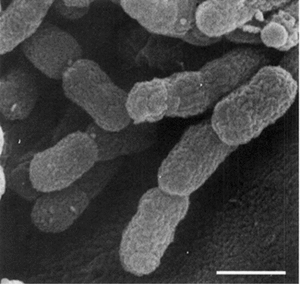Carnimonas nigrificans
Title: Carnimonas nigrificans Bacteria commonly known for black spots on cured meats Microbe image: Classification: Species: Description & Significance Genome structure Cell structure, metabolism, life cycle ecology & pathogenesis references
Classification
Domain; Bacteria Phylum; Pseudomonadota Class; Gammaproteobacteria Order; Oceanospirillales family; Halomonadaceae Genus: Carnimonas species; nigrificans
Species
Carnimonas nigrificans.
Description and Significance
Describe the appearance, habitat, etc. of the organism, and why you think it is important. C. nigrificans gets to a size of approximately. Optimal growth temperature is between 28-30 degrees C. C. nigrificans can grow in up to 8% sodium chloride. C. nigrificans usually grows to 0.5µm-0.6µm width, and up to 7µm length.
Genome Structure
Describe the size and content of the genome. How many chromosomes? Circular or linear? Other interesting features? What is known about its sequence?
Carnimonas nigrificans has 2,390 total genes and 225 genetic pathways. C. nigrificans has 1,180 enzymatic reactions and 77 transport reactions. C. nigrificans has 2,312 polypeptide genes, 39 protein complexes, 798 enzymes, 277 transporters, 895 compounds, 1,744 transcriptional units, 50 tRNAs, and 4 GO terms. C. nigrificans has circular chromosomes.
Cell Structure, Metabolism and Life Cycle
Interesting features of cell structure; how it gains energy; what important molecules it produces.
Carnimonas nigrificans is a Gram-negative and catalase-positive bacteria. C. nigrificans is an obligate aerobic organism, and is rod shaped. The G+C content of DNA of strain CTCBS1T of C. nigrificansis 56.0 +/- 0.3 mol%.
Ecology and Pathogenesis
If relevant, how does this organism cause disease? Human, animal, plant hosts? Virulence factors, as well as patient symptoms.
C. nigrificans toxicological studies have shown no known pathogenicity towards humans.C. nigrificans grows on cured meat products. The polar lipid composition of C. nigrificans is diphosphatidyl-glycerine, phosphatidylglycerine and phosphatidyl-ethanolamin, along with several other unidentified compounds.
References
Garriga M, Ehrmann MA, Arnau J, Hugas M, Vogel RF. Carnimonas nigrificans gen. nov., sp. nov., a bacterial causative agent for black spot formation on cured meat products. Int J Syst Bacteriol. 1998 Jul;48 Pt 3:677-86. doi: 10.1099/00207713-48-3-677. PMID: 9734022.
Subhraveti, P., Keseler, I., Kothari, A., Caspi, R., & Karp, P. D. (n.d.). Summary of Carnimonas nigrificans ATCC BAA-78, version 27.1 Tier 3 Uncurated Database. Summary of carnimonas nigrificans ATCC BAA-78, version 27.1. https://biocyc.org/organism-summary?object=GCF_000526695&sid=biocyc13-3908806087]
[Garriga, M., Ehrmann, M. A., Arnau, J., Hugas, M., & Vogel, R. F. (1998, July 1). Carnimonas nigrificans gen. Nov., sp. nov., a bacterial causative agent for black spot formation on cured meat products. microbiologyresearch.org. https://www.microbiologyresearch.org/content/journal/ijsem/10.1099/00207713-48-3-677?crawler=true
Garriga, M & Ehrmann, Matthias & Arnau, Jacint & Hugas, Marta & Vogel, R. (1998). Carnimonas nigrificans gen. nov., sp. nov., a bacterial causative agent for black spot formation on cured meat products. International journal of systematic bacteriology. 48 Pt 3. 677-86. 10.1099/00207713-48-3-677.
Author
Page authored by AJ Schwarz, student of Prof. Bradley Tolar at UNC Wilmington.

